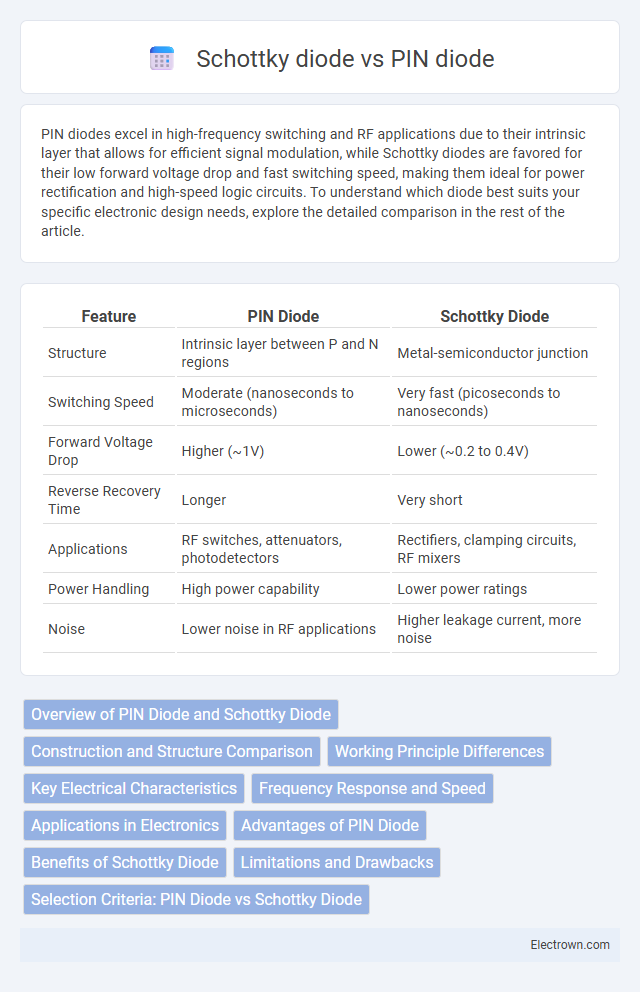PIN diodes excel in high-frequency switching and RF applications due to their intrinsic layer that allows for efficient signal modulation, while Schottky diodes are favored for their low forward voltage drop and fast switching speed, making them ideal for power rectification and high-speed logic circuits. To understand which diode best suits your specific electronic design needs, explore the detailed comparison in the rest of the article.
Table of Comparison
| Feature | PIN Diode | Schottky Diode |
|---|---|---|
| Structure | Intrinsic layer between P and N regions | Metal-semiconductor junction |
| Switching Speed | Moderate (nanoseconds to microseconds) | Very fast (picoseconds to nanoseconds) |
| Forward Voltage Drop | Higher (~1V) | Lower (~0.2 to 0.4V) |
| Reverse Recovery Time | Longer | Very short |
| Applications | RF switches, attenuators, photodetectors | Rectifiers, clamping circuits, RF mixers |
| Power Handling | High power capability | Lower power ratings |
| Noise | Lower noise in RF applications | Higher leakage current, more noise |
Overview of PIN Diode and Schottky Diode
PIN diodes feature an intrinsic layer between the p-type and n-type regions, enabling them to act as efficient RF switches and attenuators due to their high-frequency performance and low distortion. Schottky diodes, characterized by their metal-semiconductor junction, offer fast switching speeds and low forward voltage drop, making them ideal for high-speed rectification and detection applications. Understanding these fundamental differences helps you select the appropriate diode for RF amplification, switching, or fast signal detection tasks.
Construction and Structure Comparison
PIN diodes consist of an intrinsic (undoped) semiconductor layer sandwiched between p-type and n-type regions, creating a wide depletion region ideal for high-frequency switching and RF attenuation. Schottky diodes feature a metal-semiconductor junction formed by directly contacting a metal with an n-type semiconductor, resulting in a low forward voltage drop and fast switching speed. The distinct construction of PIN diodes supports high-power and high-frequency applications, while Schottky diodes excel in low-voltage, high-speed rectification due to their metal-semiconductor interface.
Working Principle Differences
PIN diodes operate with an intrinsic layer sandwiched between the p-type and n-type regions, allowing them to behave as variable resistors controlled by the injection of charge carriers, making them ideal for RF switching and attenuators. Schottky diodes rely on the metal-semiconductor junction that creates a low forward voltage drop and fast switching speeds by facilitating majority carrier conduction without charge storage. The fundamental difference lies in the PIN diode's charge storage mechanism affecting its slow switching behavior, whereas the Schottky diode's metal-semiconductor contact enables rapid switching with minimal forward voltage loss.
Key Electrical Characteristics
PIN diodes exhibit high voltage handling capability and low capacitance, making them ideal for RF switch and attenuator applications, with a typical forward voltage drop around 0.7V and reverse recovery time in the microseconds range. Schottky diodes are favored for their ultra-fast switching speeds, extremely low forward voltage drop (typically 0.2-0.3V), and minimal junction capacitance, which enhance efficiency in high-frequency rectification and detection circuits. The choice between PIN and Schottky diodes depends on the specific requirements for reverse recovery speed, conduction loss, and high-frequency performance in the target application.
Frequency Response and Speed
PIN diodes exhibit superior frequency response and switching speed in RF and microwave applications due to their intrinsic layer that facilitates fast charge carrier removal, enabling efficient operation at high frequencies up to several GHz. Schottky diodes offer even faster switching speeds with low junction capacitance and minimal forward voltage drop, making them ideal for ultra-high-speed applications typically exceeding tens of GHz. The choice between PIN and Schottky diodes depends on the specific frequency range and speed requirements, with Schottky diodes favored for rapid switching and PIN diodes preferred for controlled RF attenuation and switching.
Applications in Electronics
PIN diodes excel in RF switch and attenuator applications due to their high-frequency performance and ability to handle high power, making them ideal for signal modulation and radar systems. Schottky diodes are favored in high-speed switching and low-voltage rectification, commonly used in power supplies, radio frequency mixers, and solar cell circuits thanks to their low forward voltage drop and fast recovery time. Your choice depends on the application's speed, frequency, and power handling requirements.
Advantages of PIN Diode
PIN diodes offer superior performance in high-frequency and RF switching applications due to their intrinsic layer, which provides high resistance and low capacitance, resulting in excellent isolation and low insertion loss. Their ability to handle high power levels and fast switching speeds makes them ideal for attenuators, RF switches, and photodetectors. Unlike Schottky diodes, PIN diodes exhibit higher linearity and lower distortion, enhancing signal integrity in communication systems.
Benefits of Schottky Diode
Schottky diodes offer significantly faster switching speeds and lower forward voltage drop compared to PIN diodes, making them ideal for high-frequency and low-voltage applications. Their minimal junction capacitance reduces signal distortion and power loss in RF circuits and power rectification. Enhanced efficiency and better thermal stability further position Schottky diodes as superior choices in power-sensitive electronic designs.
Limitations and Drawbacks
PIN diodes exhibit slower switching speeds and higher power consumption compared to Schottky diodes, limiting their efficiency in high-frequency applications. Schottky diodes, while offering faster switching and lower forward voltage drop, suffer from higher reverse leakage current and lower maximum voltage ratings. These limitations restrict PIN diodes' use in ultra-fast circuits and Schottky diodes in high-voltage environments.
Selection Criteria: PIN Diode vs Schottky Diode
When selecting between a PIN diode and a Schottky diode, consider the application's frequency, switching speed, and power handling requirements. PIN diodes excel in RF switching and attenuator circuits due to their high-frequency performance and low distortion, while Schottky diodes offer fast switching speeds and low forward voltage drops ideal for high-speed rectification and power-efficient applications. Your choice depends on whether priority is given to high-frequency signal integrity with PIN diodes or ultra-fast response and efficiency with Schottky diodes.
PIN diode vs Schottky diode Infographic

 electrown.com
electrown.com